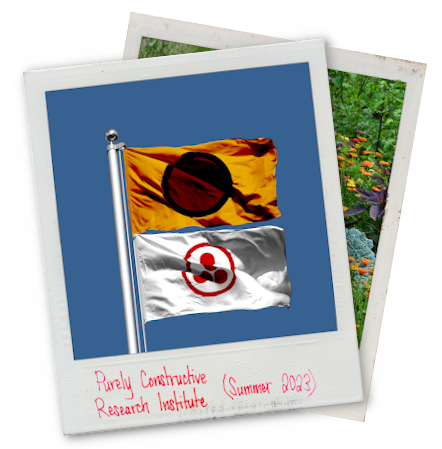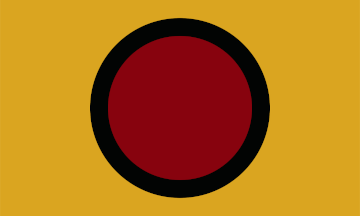


A flag is a symbol that can carry meaning within it. It can serve as a tool used in various ways. It can communicate something to others without the words. It can bring people together based on a common understanding. It can serve as a reminder of goals and responsibilites. Most generally, it can inspire us into thought and into action.There is some beautiful symbolism behind this flag [*organized here in a table]:
| Meaning of Shapes | Meaning of Colors |
|---|---|
| The dot represents unity: striving for the greatest possible unity under a common destiny for humanity. It represents Earth. | Carmine represents everyone working toward a global and sustainable gift economy. |
| The ring represents mutuality: striving for the greatest benefit for living beings in the recognition of mutual interdependence. It represents our biosphere. | Obsidian represents everyone working toward a just and equal society for humans and animals. |
| The background represents interconnectivity: striving for the greatest understanding of our social and natural environment and our relation to it. It represents our solar system. | Goldenrod represents everyone working toward a better future for all living beings in general. It represents our galaxy. |

The world peace flag is based on a design by the Russian artist and mystic Nicholas Roerich, who proposed the red circle with three dots inside as an international symbol to mark museums, schools, and similar cultural landmarks to prevent destruction by aerial bombs [...] this [was] about the time of World War I. The idea was similar to the large red cross that marks hospitals and hospital tents in war zones [...] similarly to "prevent" bombing and strafing of helpless patients and medical personnel...The middle symbol is often referred to as the "Pax Cultura" (or "Culture of Peace"). While it has been superseded by the "Blue Shield" symbol within most international contexts, it has an interesting history and meaning. To quote the Wikipedia page on the Hague Convention for the Protection of Cultural Property in the Event of Armed Conflict:
Nicholas Roerich, who designed it with early symbolism in mind, described the significance of the three points as a symbol of art, science and religion as the three most important cultural activities of humanity, with the circle as the element that linked these three aspects in the past, present and future.It is interesting to note that, minus the symbol, "The International Banner of Peace" is essentially a white flag. To quote The Military Wiki:
The white flag is an internationally recognized protective sign of truce or ceasefire, and request for negotiation. [...] A white flag signifies to all that an approaching negotiator is unarmed, with an intent to surrender or a desire to communicate. Persons carrying or waving a white flag are not to be fired upon, nor are they allowed to open fire. [...] The improper use of a white flag is forbidden by the rules of war and constitutes a war crime of perfidy...This is important history that cannot be reiterated enough. To quote History.com [*extra link and emphasis in bold added by me]:
...Most historians believe blank banners first caught on because they were easy to distinguish in the heat of battle. Since white cloth was common in the ancient world, it may have also been a case of troops improvising with the materials they had on hand. The white flag later became well established in Western warfare, but evidence shows it also arose independently in China during the Eastern Han dynasty in the first three centuries A.D. The color white has long been associated with death and mourning in China, so its soldiers may have adopted white surrender flags to show their sorrow in defeat.Peace transcends space and time, and all of human culture and effort can be pointed towards it. Wherever you may find yourself, always plant your seeds with Love and your harvest shall always be abundant. Please take some "seeds" with you before you go...
In more recent history, the white flag has become an internationally recognized symbol not only for surrender but also for the wish to initiate ceasefires and conduct battlefield negotiations. Medieval heralds carried white wands and standards to distinguish themselves from combatants, and Civil War soldiers waved white flags of truce before collecting their wounded. The various meanings of the flag were later codified in the Hague and Geneva Conventions of the 19th and 20th centuries. Those same treaties also forbid armies from using the white flag to fake a surrender and ambush enemy troops.